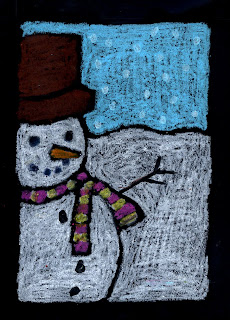 Here's a simple crayon and watercolor painting idea that was inspired by an illustration on a stock art website.
Here's a simple crayon and watercolor painting idea that was inspired by an illustration on a stock art website.1. As the students will first need to draw with a white crayon on white paper, I've found it helpful to trace 9 large circles very lightly in pencil to use as a guide. As a starting point, I encouraged the students to make an "X" in the middle of each circle, and then a horizontal line through the middle so their flake will have 6 legs. After that, they may add dots or arrows to each, but they must press very hard and draw slowly to leave a lot of crayon on the paper.
2. Once you are certain that there is a snoflake drawn in the middle of each circle, pass out lots of liquid watercolors. When the students fill in each pencil circle with paint, the snowflake will "magically" appear. A simple project with beautiful results, I think.


 9:43 PM
9:43 PM
 keprok
keprok




























